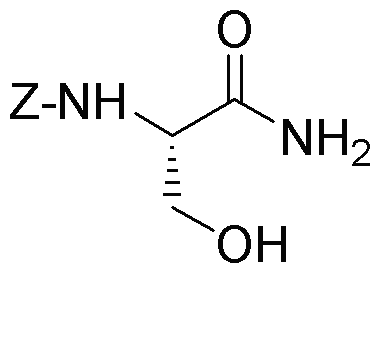Z-L-serine amide is widely utilized in research focused on:
- Peptide Synthesis: This compound serves as a valuable building block in the synthesis of peptides, particularly in the development of biologically active compounds and pharmaceuticals.
- Neurotransmitter Research: It plays a role in studying neurotransmitter pathways, particularly in relation to serine metabolism, which is crucial for understanding neurological disorders.
- Drug Development: Z-L-serine amide is used in the design of new drugs, especially those targeting metabolic pathways, enhancing the efficacy of treatments for various diseases.
- Biochemical Assays: It is employed in biochemical assays to evaluate enzyme activity and protein interactions, helping researchers understand cellular processes.
- Cosmetic Formulations: The compound is also explored in cosmetic applications for its potential benefits in skin hydration and repair, appealing to the beauty industry.
General Information
Properties
Safety and Regulations
Applications
Z-L-serine amide is widely utilized in research focused on:
- Peptide Synthesis: This compound serves as a valuable building block in the synthesis of peptides, particularly in the development of biologically active compounds and pharmaceuticals.
- Neurotransmitter Research: It plays a role in studying neurotransmitter pathways, particularly in relation to serine metabolism, which is crucial for understanding neurological disorders.
- Drug Development: Z-L-serine amide is used in the design of new drugs, especially those targeting metabolic pathways, enhancing the efficacy of treatments for various diseases.
- Biochemical Assays: It is employed in biochemical assays to evaluate enzyme activity and protein interactions, helping researchers understand cellular processes.
- Cosmetic Formulations: The compound is also explored in cosmetic applications for its potential benefits in skin hydration and repair, appealing to the beauty industry.
Documents
Safety Data Sheets (SDS)
The SDS provides comprehensive safety information on handling, storage, and disposal of the product.
Product Specification (PS)
The PS provides a comprehensive breakdown of the product’s properties, including chemical composition, physical state, purity, and storage requirements. It also details acceptable quality ranges and the product's intended applications.
Certificates of Analysis (COA)
Search for Certificates of Analysis (COA) by entering the products Lot Number. Lot and Batch Numbers can be found on a product’s label following the words ‘Lot’ or ‘Batch’.
*Catalog Number
*Lot Number
Certificates Of Origin (COO)
This COO confirms the country where the product was manufactured, and also details the materials and components used in it and whether it is derived from natural, synthetic, or other specific sources. This certificate may be required for customs, trade, and regulatory compliance.
*Catalog Number
*Lot Number
Safety Data Sheets (SDS)
The SDS provides comprehensive safety information on handling, storage, and disposal of the product.
DownloadProduct Specification (PS)
The PS provides a comprehensive breakdown of the product’s properties, including chemical composition, physical state, purity, and storage requirements. It also details acceptable quality ranges and the product's intended applications.
DownloadCertificates of Analysis (COA)
Search for Certificates of Analysis (COA) by entering the products Lot Number. Lot and Batch Numbers can be found on a product’s label following the words ‘Lot’ or ‘Batch’.
*Catalog Number
*Lot Number
Certificates Of Origin (COO)
This COO confirms the country where the product was manufactured, and also details the materials and components used in it and whether it is derived from natural, synthetic, or other specific sources. This certificate may be required for customs, trade, and regulatory compliance.


